
VOLUME II
September 2022
Introducing the Ranch Water Gazette. We’re here to de-mystify solar pumping and support every off-grid water journey – without the need for a power company. Our monthly publication is a collection of educational and timely information about water access, pumping, solar, ranch power and water independence from around United States of America – inspired by all the amazing customers we serve here at RPS Solar Pumps. We’re honored to serve you and become a teammate in your solar pump planning and installation.

Ode to the Rancher, the Farmer and the Off Grid Pioneer…
To those not afraid of hard work. Not afraid of rolling up their sleeves and fixing something that is broken or building something new. To those that honor their land, their animals and their heritage. To those growing food, feeding animals, working the land, harvesting their own power from the sun, pumping their own water. To pioneers and problem solvers. To self reliance and independence. We, here at RPS Solar Pumps, salute you. Cheers to you.
DIY: PUMP SLEEVE
ARMOR YOUR PUMP AND IMPROVE YOUR FLOW
DIY Pump Sleeves help encourage water flow cooling around your pump’s motor when horizontal, and in sandy wells, encourages sand to fall down safely past the pump intake. We use the term ‘pump sleeves’ but it’s also commonly called a ‘flow sleeve’, ‘flow inducer’, and ‘pump shroud’.
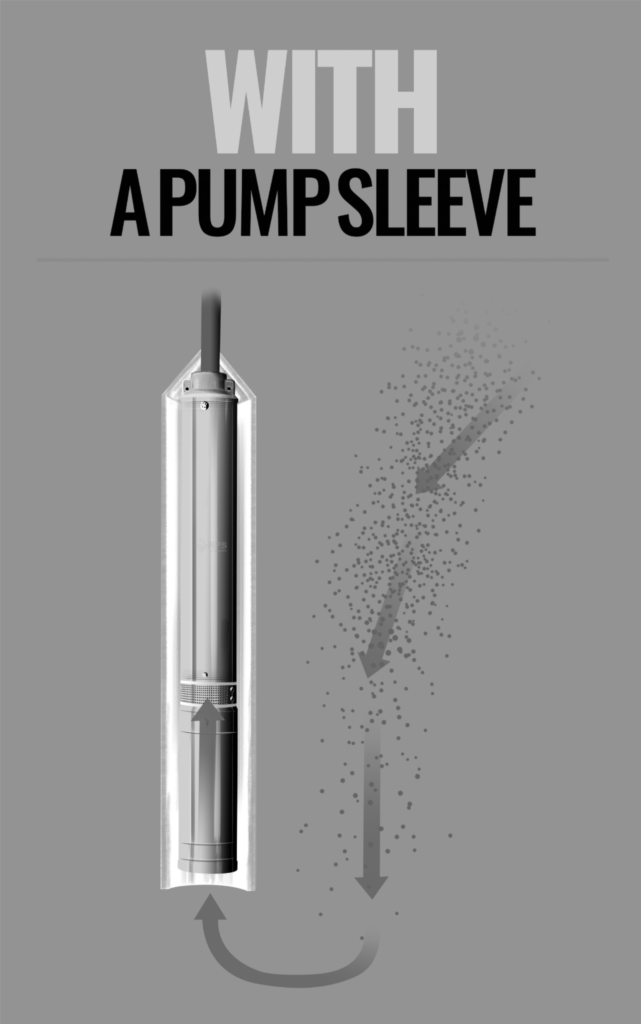

While DC Brushless Motors used in RPS Solar Pumps do not generate nearly the heat of induction motors, cooling of the lower motor end is still important. When pumping from larger water sources, such as above ground tanks, cisterns, ponds, or in much larger diameter wells, heat dissipation is a bigger issue as water’s path of least resistance is flowing directly into the middle intake of the pump, and not flowing around the pump’s motor. In these situations, a pump sleeve is highly recommended.
In the case of sandy wells or rusty casing wells, pump sleeves are also recommended if the well is top feeding (water flows in from above), or when a pump is placed below the wells perforations/screens so that the sand is able to fall down past the pump and get pulled into the pump’s intake.
A common DIY Pump Sleeve we recommend is simply a piece of 3″ or 4″ PVC (depending on RPS Pump Model and Well Casing Size) and with a reducing coupling at the top that prevents water from flowing into the middle pump intake, and instead encourages it to flow from the bottom, up around the motor to cool it before entering the intake. Most recommend cutting the PVC about a foot longer than your assembled pump. PVC pipe with thinner walls is fine. A rubber reducing coupling with hose clamps can be used to fasten around the wire and plumbing at the top, which expands onto a hose clamp on the PVC pipe to hold it in position and prevent it from slipping down and off the pump.
Below are excellent examples of homemade DIY pump shroud/prefilter from our friend Todd in Wyoming. Notice that he wrapped the mesh around twice, providing double protection from damaging sediment. This one was to float horizontally in a spring, so holes were added along the length of the PVC but the rest of the concept remains the same to a traditional pump shroud.
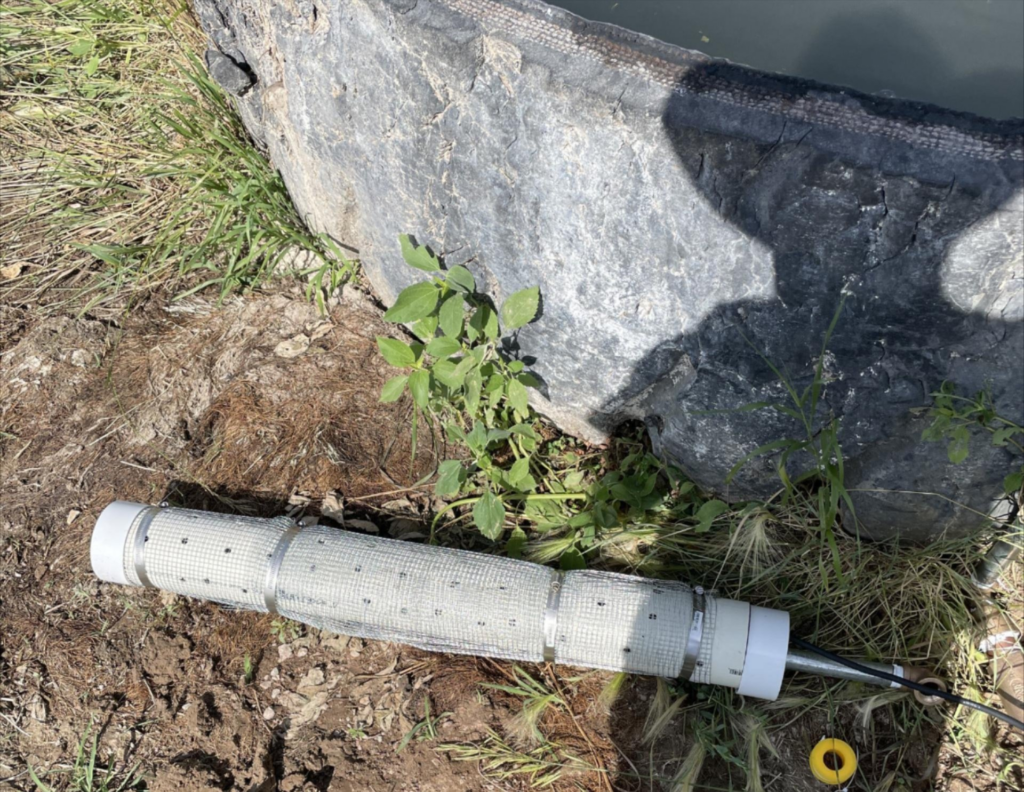
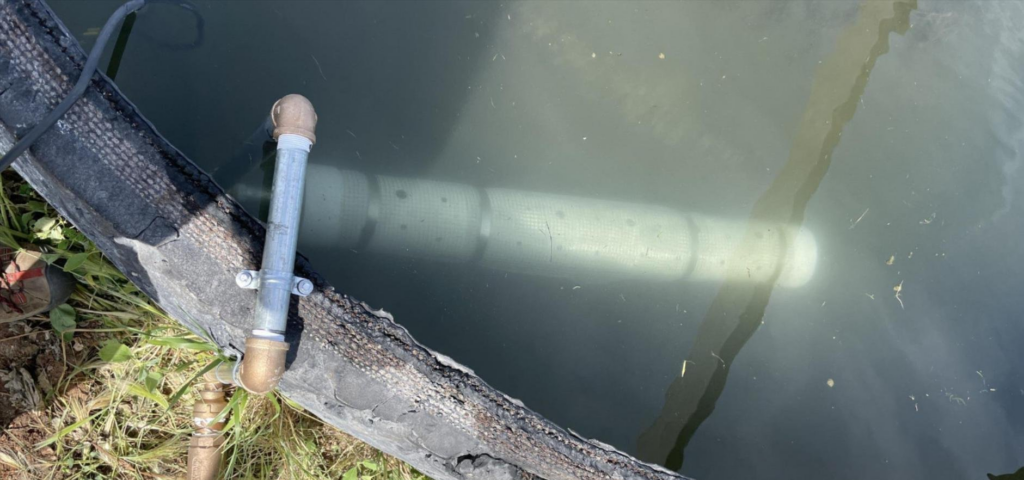
Looks like he followed our video tutorial to the letter. Watch it yourself here!
BACKUP POWER
Generally solar pump customers get more water then they think (even pumping on cloudy/hazy days!) but its good to plan for days with less or no sun.
How else can you power a solar pump system?
A number of solar pumps of high voltage are designed for use with solar or 220v AC power only. Lower voltage pumps can generally be run off solar and batteries directly. Usually generators or AC power are also options with an AC to DC converter. There is also a converter (usually a DC to DC step-up) for running off your trucks battery if needed.

Pumping + Charging batteries vs Pumping Only
With systems that are capable of doing so, you’ll be able to select SOLAR or BATTERY modes. In BATTERY mode the solar panels will charge the batteries, and the pump will run off battery power rather than solar power directly. The solar charge controller inside your pump controller that facilitates charging, prevents overcharging, and prevents discharging batteries to a damaging level. It should be mentioned that during charging, some power and voltage is lost, leading to a 15% to 25% decrease in pumping efficiency. These decreases are greater for deeper wells and higher heads.
What Type of Batteries should I use?
Batteries must be deep-cycle batteries, not standard car batteries. Deep-cycle batteries are designed to accommodate much lower continual discharges than regular car batteries and are usually sold as “marine” or “RV” batteries. Lead Acid Batteries are the cheapest deep-cycle batteries and are easiest to find. Most customers feel Lithium-Ion batteries are still too expensive. AGM batteries are also an increasingly popular option.
How many batteries do I need?
If you are adding batteries in order to pump more water than is possible in a solar day, you will need to increase the number of solar panels in your system. Add solar panels in parallel to maintain the same voltage to the controller. More batteries can also be added for greater total storage capacity, as long as they are added in parallel at the same voltage. Batteries should be at the same voltage as the Solar Panel Array. Use 12v batteries in sets of 2 in series for 24v systems and sets of 4 for the 48v systems. More sets can be added in parallel as needed, but we recommend starting small and adding as needed. (If using 6v batteries, you’ll need double the number series!) Battery and solar panel wiring diagrams are available for RPS solar pumps as an example.
As usual, we have a whole video walking you through each of these options.
MEASURING STATIC vs. WELL LOG
Sometimes you’ll need both!
Need Help Finding Your Well Log?
We’ve compiled a list of well log databases by state, if your state doesn’t have a link or you aren’t able to find your well log within one of these databases, contact your local county office and they may have the well log on file. Well log records reliability depends on when a state or county passed laws requiring well drillers to submit copies of logs after drilling. Some of these laws passed recently, some passed back in the late 1900’s. As a last ditch effort you may try to contact the well driller directly to see if they still have your well log on file. The driller’s name is sometimes found on the well casing or near the pump controller.
Can’t find your well log?
RPS has instructions on how to DIY measure your static water level and casing diameter.
CUSTOMER OF THE MONTH:
SKIP, Montana
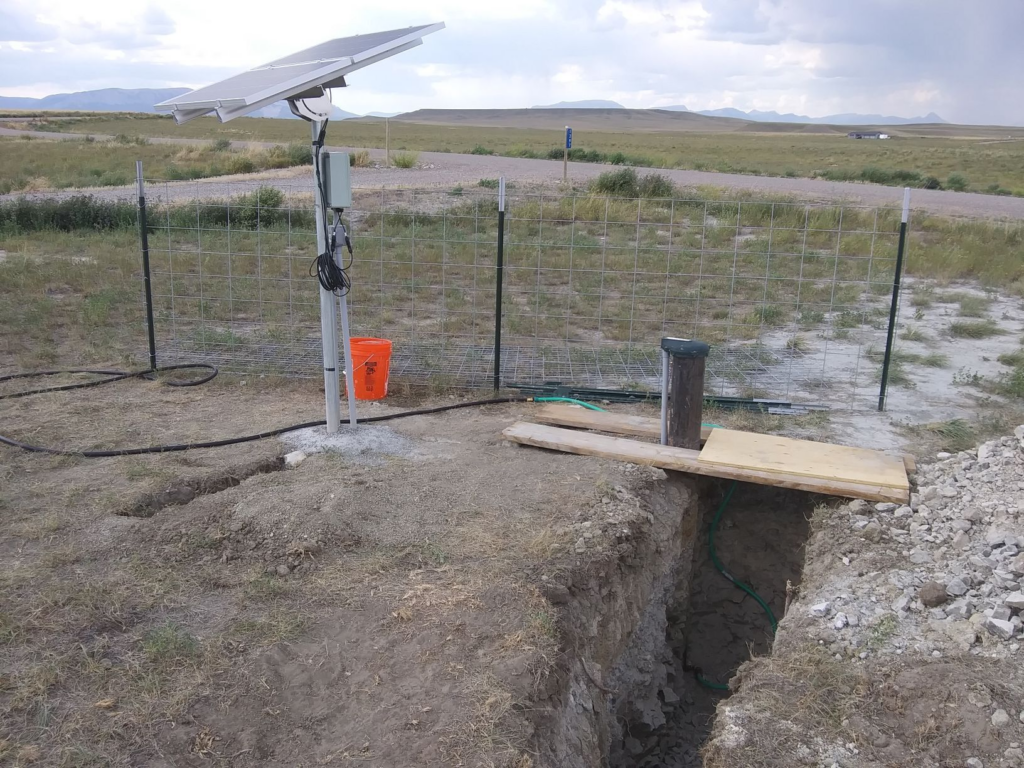

MONTANA – “The system is working well, despite the condition of my well. The well is NOT a good producer, but there is water down there to be had. I’m pumping into barrels to monitor the volume and recharge rate (which is measured in days, not hours). With the pump speed set at 2 and with cloudy weather, it took two days to pump to “well low” condition. The pump is set at about 80 feet below top of casing and static water level was at 33 feet below top of casing. I expect to have the water line to the cistern trenched and ready to be connected in about another week. Last step before connecting will be to have pumped enough water out to get a good sample for testing.
One feature that would be helpful in my situation is a time that could be set for longer than 30 minutes – say 120 minutes. At such a slow recharge rate, not much changes in just 30 minutes.
I’m expecting that recharge improves as I continue to pump. We are in drought after all and a neighbor’s well went dry. So, I’m grateful to have anything at all.” – Skip
HELICAL VERSUS CENTRIFUGAL PUMPS
Our bulletproof RPS Solar Pumps come in two varieties: Centrifugal and Helical. In this video, Mike illustrates the differences and pros and cons of each to help you decide which pump is best for you.
Diaphragm and piston pumps are other positive displacement pumps. They offer low volume and sometimes high head, but are more susceptible to damage from sand and often paired with brushed motors and not rated for continuous duty. Brushed motors and diaphragms wear out quickly which are especially hard to replace down a well.

3″ Helical Rotor Pumps
RPS 200 Solar Well Pump Kit (150′ Head)
RPS 800 Solar Well Pump Kit (Highest head 3″ Pump on the market)
3″ Centrifugal Pumps
4″ Pro Centrifugal Pumps
RUNNING THE NUMBERS
DAILY CATTLE WATER REQUIREMENTS
“You guys doin’ okay on water?” If only our cattle could answer back! Since they can’t, it’s imperative that we understand their hydration needs. This is generally second nature to everyone but there is a lot of research out there too. The ’98 Hicks research yielded an equation which uses only three factors to determine how much water to provide your herd.
1. Average Cow weight
2. Average Temperature (Fahrenheit)
3. Head of Cattle
Lactating cows will require slightly more water. The NRCS and USDA have some general estimates of 15-25 gallons/day and it often depends on your state what you hear from them on a final number.
To save you some time, we’ve put this equation into this handy calculator; simply input these three factors and we’ll tell you how many gallons per day you need to pump for any given herd.

SOLAR PUMPS VS WINDMILLS VS GENERATOR VS GRID:
5 YEAR COST ANALYSIS
This feels a little promotional as we write it, but having seen and heard lot of misinformation over the years about the total cost of installing and running a variety of different water pumping options, we spent time analyzing the options and comparing the upfront costs, the operating expenses, and labor/maintenance. We used 500 gallons per day as an estimate but it really changes a lot depending on demand. Take it for what it is as it’s hard to estimate anything these days but it’s trying to factor in “cost of ownership” over time vs. upfront costs. Solar pumps tend to look really good in that light as an investment, all be it sometimes more upfront cost than other options. We put the itemized breakdown of these costs here on our website.

HITTING THE ROAD: LIVESTOCK SHOWS
‘Tis the season for livestock shows! Parades of prize animals strutted their stuff this September in time-honored agricultural tradition, and the RPS team couldn’t resist a visit. At the Yolo County Fair up the road from our headquarters and the Slots of Fun in Corning, we spoke with many ranchers and farmers who have been considering taking their water off the grid for some time but lack the educational resources to do it themselves. RPS was founded with them in mind; they all left our booth with brochures, catalogs, and access to the largest and most comprehensive collection of insider solar pumping information available (and some free swag).
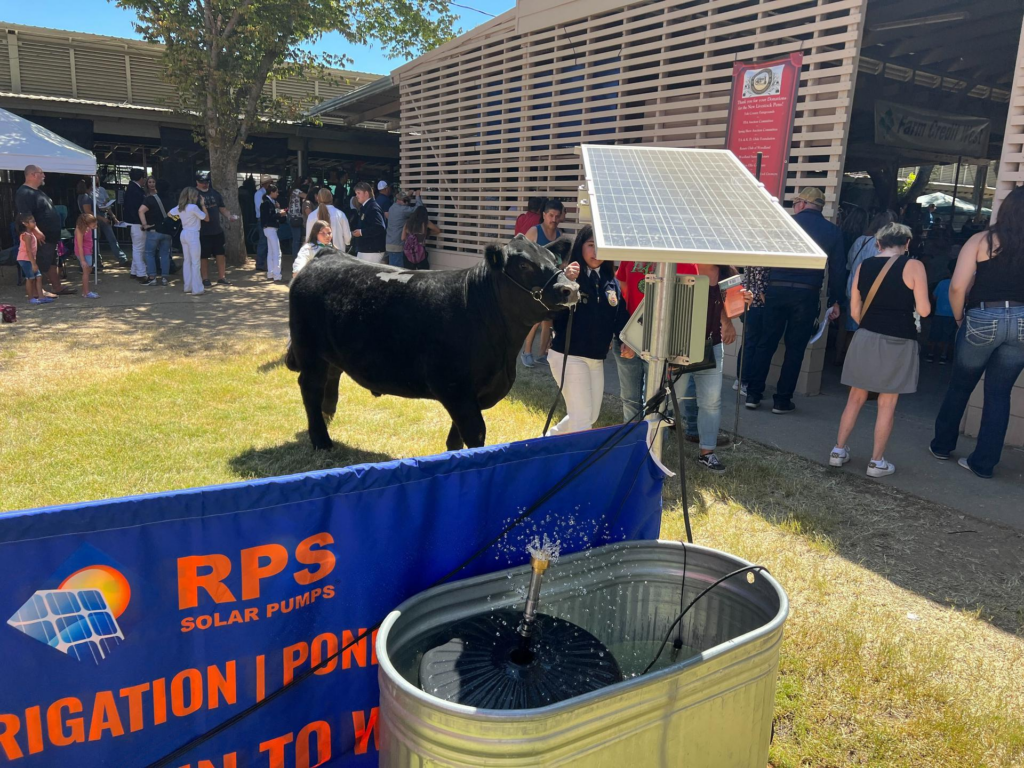

BLEACHING YOUR WELL?
It may seem like overkill, but if a water test detects high levels of bacteria in your groundwater or your cows are shying away from their stock tank, bleaching your well may be the only option.
Care must be taken to get accurate measurements of the water volume in your well in order to get the right ratios of bleach in order to disinfect your well properly. We can’t advise you to do this technique, but we can say that this video outlines the process nicely and it is the preferred technique. There are others available on the internet as well but the Canadians do a nice job outlining everything here 😉
RECIPES FROM OUR GARDEN
Zucchini Fritters
One of our favorites here at RPS! A simple, filling crowd-pleaser, they make a great handheld snack during meetings and breaks.
INGREDIENTS
1 lb zucchini (Our garden grows yellow, but green works too!)
1 teaspoon kosher salt
2 large scallions, split lengthwise then chopped
1 large egg, beaten
½ teaspoon ground pepper
½ cup all purpose flour
1 teaspoon baking powder
3-4 tablespoons vegetable oil for frying
½ cup sour cream
1-2 garlic cloves, chopped
juice from ¼ a lemon
zest from ¼ of a fresh lemon

Step 1
In a large bowl, mix together the zucchini, onion, eggs, Romano cheese, milk, and flour. Season with salt, pepper, garlic powder, onion powder, and parsley.
Step 2
Heat about 1 tablespoon of shortening in a large skillet over medium heat. Drop 1/4 cupfuls of the batter into the skillet, and flatten slightly with the back of a spatula. Turn fritters over when the center appears dry. Cook on the other side until golden brown. Set aside and keep warm. Add more shortening to skillet as needed, and continue with remaining batter.
In the office we’re a fan of sauce smorgasbords, and we’ve found these go well with just about anything! Sour cream, salsa, applesauce, you name it.
A PEEK BEHIND THE CURTAIN

In the sweltering summer heat of our Northern California headquarters, our team of solar pumping experts could think of only one way to cope: by sampling every brand of ice cream sandwich available at our local grocery store. Opinion turned to schism, so we put it to a vote. Of nine brands, A brand called Its-It came out on top! The Oreo ice cream sandwich was a close second. In the end I think everyone won!
888-637-4493 RPS Water Assurance™ guarantees you’ll have the right pump before you install! Click to size online or call 888-637-4493
Pump Sizing & Pricing >>

- CORRESPONDENCE FROM THE FIELD -Do you have a news story or update from your part of the world about water, solar pumping animals, farms or ranches? Send a letter to our owners (Mike from the videos is one!) at [email protected], and your insight might be shared in the next newsletter!
40250 County Road 27, Woodland CA 95776 No longer interested in a solar pump? Let us know here
